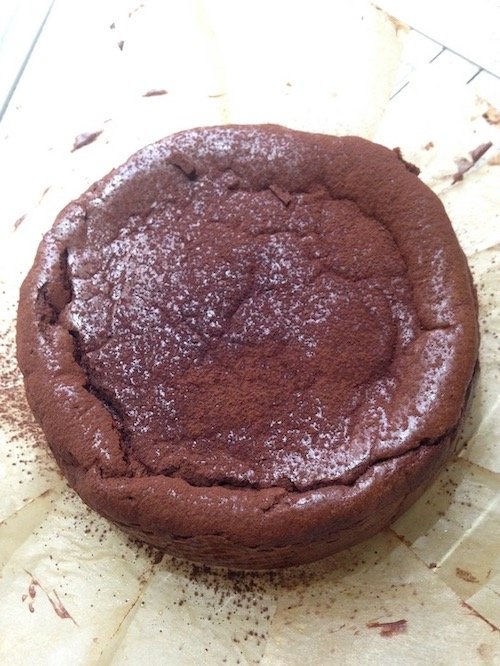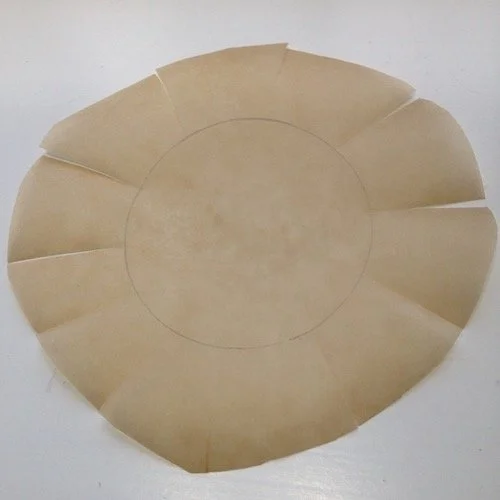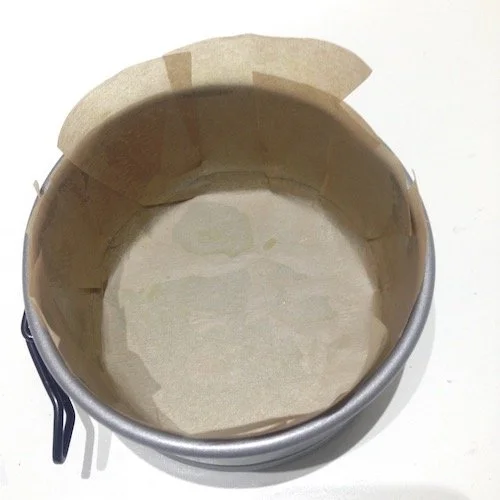Flourless salted chocolate mousse cake
This cake is sumptuously rich and decadent. Yet it’s also incredibly delicate. And that’s what I love about it most: the game of textural contrasts that it plays with your senses.
Beating the eggs to full volume creates a very thin, crackling layer of meringued crispiness on the outside – indicated by the cracking – yielding to a velvety soft and delicate interior, with a mouthfeel that’s somewhere betwixt and between the languorous weightiness of chocolate truffles and the vanishing lightness of a mousse. A mousse that spritzes gently on the tongue before performing its disappearing act.
Each mouthful teases the senses, making you stop and wonder: Is it crisp/soft, weighty/light, dense/fine, smooth/aerated? The delightful conclusion: Ohhh! It’s all of those things!
When food arrests, when it pulls you into the moment and makes you stop and think like that, the experience of eating not only becomes more vivid and intense, but more memorable. The action of pausing to process the rush of sensory input – the complexity of flavour and textural interplay – beds that experience down in memory. What a precious gift to give to yourself and the privileged people you choose to share this dark beauty with.
Containing only the sugar in the bar of 85% dark chocolate (a piffling 15g) and a single tablespoon of honey, this cake is very low in sugar as cakes go. One slice contains just 5.7g free sugars (defined below) (picture a rounded teaspoon), less than a fifth of the maximum everyone aged 11yrs and over should eat in a day (no more than 30g), placing it firmly in the ‘healthy indulgence’ camp!
UK advice on sugar intakes
UK advice is that free sugars should make up no more than 5% of total dietary energy (the calories you get from food and drink each day, including alcohol) for all age groups from 2 years upwards.[1]
On average, that’s equal to no more than 30g/day for everyone aged 11+ years.
The definition of free sugars in the UK
Free sugars include:
All sugars added to foods or drinks by the manufacturer, cook or consumer
Including those naturally present in honey, syrups and nectars
As well as those in unsweetened fruit and vegetable juices, smoothies, purées, pastes and similar products in which the structure has been broken down (by juicing, blending, pulping, puréeing, or powdering), making them freely available to the body.
Free sugars exclude:
The sugars (lactose) naturally present in milk and dairy products
Those contained within the cellular structure of foods, including those in fresh and most types of processed fruit and vegetables, in cereal grains, nuts and seeds.[1,2]
What’s great about it
Contains no added sugar, just the 15g in the bar of 85% dark chocolate and a tablespoon of honey.
One serving contains:
Less than a fifth of the maximum amount of sugar you should eat in a day – only 5.7g free sugars, no more than 30g free sugars per day being the advice for everyone aged 11+ years
A tenth of your recommended daily intake of fibre (3g of 30g) – impressive for a slice of cake! For foods to be called a ‘source of fibre’ they must contain ≥3g fibre/100g and ≥6g/100g to be classed as ‘high fibre’. At 5g/100g, this cake is a source of fibre and while it’s not quite high in fibre, it’s getting there – again, deeply impressive for a cake! The fibre comes from the high percentage dark chocolate, which is extremely high in fibre – 13g/100g or more for 85% dark chocolate, depending on brand,[3] 16g/100g for the Lindt 85% I used.[4]
Dark chocolate is rich in minerals.
It’s also one of the top-richest dietary sources of polyphenols.[5]
Suitable for low-GI and keto diets.
Being flourless, it’s naturally gluten-free.
Thinking of optimising your health with your diet?
How many of your ≥5-A-Day: 0 per serving
Plant points: 1.25
Time
Prep: 20-30 minutes
Cooking: 17-20 / 30-35 minutes
Ingredients
I make this cake in a 6-inch tin, which gives 6 servings, enough for the bf and I. In case you’re catering for more, or are even more crazy about chocolate than us, I’ve also given the quantities for an 8-inch tin, which gives 12 servings.
6-inch (serves 6)
100g 85% dark chocolate, e.g. Lindt
88g salted grass-fed cultured butter, fridge cold, cubed (see recommendations below)
25g/1 rounded tablespoon honey (maple syrup or agave nectar would also work)
5g/rounded ½ teaspoon vanilla paste or 10g/2 teaspoons vanilla extract, the best quality you can get
Level ¼ teaspoon finely ground pink Himalayan/sea salt
3 organic free-range medium eggs, at room temperature
8-inch (serves 12)
200g 85% dark chocolate, e.g. Lindt
175g salted grass-fed cultured butter, fridge cold, cubed
50g/2 rounded tablespoons honey (or maple/agave)
10g/1 rounded teaspoon vanilla paste or 20g/4 teaspoons vanilla extract, the best quality you can get
Level ½ teaspoon finely ground pink Himalayan/sea salt
6 organic free-range medium eggs, at room temperature
Method
Line the tin:
Preheat the oven to 150°C.
Line the base and sides of a 6 or 8-inch springform cake tin with baking parchment paper. So that I can easily lift the delicate cake out of the pan, I use the base to draw a circle on the paper, then draw a larger concentric circle around it, the width of the outer circle matching the depth of the sides of the tin. Cut out around the outer circle, then make a series of cuts from the outer to inner circle, to create ‘petals’ around the inner circle (pictured below left).
Flip the circle over and use a pastry brush to lightly oil the underside of the petals; there’s no need to oil the centre.
Return the base to the tin and lock the catch at the side. Place the inner circle at the bottom of the tin, allow the petals to fall into place at the sides, then press them down with your fingers to stick them into place. Any bits not adhering to the tin or overlapping paper underneath, go in with the oiled pastry brush to glue them down (as pictured, below right).
Baking parchment, drawn and cut to fit the tin
The lined tin, ‘petals’ lightly oiled into place
Prepare the ingredients:
5. Prepare the ingredients. If using large flat squares of chocolate like Lindt, break each one into 4 and place in a plastic bowl if melting in the microwave (plastic prevents the chocolate from scorching, glass develops heat spots), or a glass bowl if using a bain marie. If using chunks of chocolate like Green & Blacks, chop the chocolate roughly with a knife.
6. Cut the cold butter into smallish cubes and set aside.
7. Melt the dark chocolate either in the microwave or a bain marie (i.e. a bowl set over a pot of very gently simmering water). If using a microwave, I find one 30-second blast then a couple of 10-second blasts is sufficient (timings will vary depending on the power of your microwave). Give the chocolate a shake/stir after each blast. If using a bain marie, do make sure the water doesn’t go beyond that very gentle simmer, or the chocolate will overheat by the time it’s melted.
8. Add the cubed butter, honey, vanilla and salt and stir to allow the heat to melt it as much as it will. Return to the microwave/bain marie and heat until the butter has completely melted (a couple of 5-10 second blasts is enough in the micro). Stir until the ingredients are evenly combined and set aside to cool slightly (so as not to cook the eggs when you combine the two).
Foam the eggs:
9. Break the eggs into a mixing bowl fitted with a wire whisk. Beat on a medium-to-high speed (I use speed 6 on my Kitchen Aid) until the eggs have reached full volume. You’ll easily recognise this point after a couple of attempts; meantime, keep an eye on the mixing bowl and stop when the eggs stop rising in the bowl. The finished result will be a light and creamy foam. Times will vary according to your mixer – mine takes 8-10 minutes, but some mixers may take as long as 15 minutes. Don’t be tempted to turn the speed up to high! Lower speeds create smaller bubbles, which are more resistant to bursting on mixing and baking, giving a lovely mousse-like texture to the finished cake.
Mix:
10. Remove the bowl and whisk attachment from the stand. Add one third of the chocolate mixture, drizzling it in in concentric circles to maximise dispersion. Then give a few turns with the whisk attachment, reaching down to the very base of the bowl to bring up the chocolate, working lightly and quickly to minimise loss of volume. Repeat with the next two third, and then the final third. Use a spatula to scrape out the remaining chocolate mixture from the bowl and give a couple of last turns with the whisk to combine. Now, switch to a large silicon spatula, and again reaching right down to the base of the bowl, give a few light and gentle folding turns, scraping the mixture up from the very base of the bowl to ensure all of the chocolate has been combined.
Bake:
11. Pour the mixture into the prepared baking tin and carefully level off the surface with a spatula. Don’t bang the tin on the side to level it or you’ll destroy some of the air you’ve worked so hard to retain!
12. To ensure the desired squidgy finish, bake until the cake is set around the edges but still slightly soft to the touch in the centre, 17-20 minutes for a 6-inch, 30-35 minutes for an 8-inch, checking at 17 and 30 minutes respectively.
TOP TIP: The cake will set up as it cools (liquefied during baking, the butter and chocolate will return to a solid state at room temp), so you need to remove it from the oven when it still looks a bit underdone. Take it out when the texture looks right to eat and it will be dry and hard by the time it cools.
13. Allow the cake to cool in the tin for 5-10 minutes, then release the catch at the side and, holding the cake by the parchment paper edges, carefully lift it out of the tin and slide onto a wire rack. Let the cake cool completely.
14. Peel off the sides of the baking parchment, slide a palette knife underneath to release the base, dust with cocoa powder and turn out onto a serving plate/cake stand.
15. Store in an airtight container in a cool, dry room where it will keep for up to 5-6 days, although it will be demolished long before then! DO NOT refrigerate as that will set the butter and chocolate hard, ruining the delicate texture. Refrigeration also dries out baked goods.
Recommended products & stockists
Isigny Ste-Mère Unpastuerised Salted Butter is my top choice of butter for this cake – a raw milk cultured butter from grass-fed cows in the Isigny Ste-Mère PDO (Protected Designation of Origin) region of Normandy. Available from Waitrose and Sainsbury’s, £3.70/250g.
Bungay Butter – the UK’s only raw milk cultured butter, made by Fen Farm Dairy in Suffolk from their own herd of grass-fed, ancient-breed cows. The richest and fullest-flavoured butter I’ve ever tasted, Bungay will undoubtedly add extra richness and depth of flavour, but I suspect its full beauty will be lost to the chocolate.
Variations
Palate not quite ready for such a dark chocolate cake yet? Just swap the bar of 85% dark choc for one of 70%. As you gradually whittle down the amount of sugar in your diet, your palate will adjust and you’ll come to enjoy the darker stuff.
Serving suggestions
Enjoy plain.
Or serve as a dessert with a quenelle of crème fraiche (Katy Rodger’s is amazing!), coconut yoghurt or whipped cream and some seasonal fruit. Preferably nothing too tart. Apricots, cherries, rasps and strawbs are all great choices in summer; brambles, damsons, plums and their compotes in autumn; perhaps some perfectly ripe or poached pear in winter.
References
Scientific Advisory Committee on Nutrition (SACN). Carbohydrates and Health. London: The Stationery Office (TSO); 2015. Available from: https://assets.publishing.service.gov.uk/government/uploads/system/uploads/attachment_data/file/445503/SACN_Carbohydrates_and_Health.pdf [Accessed 6th January 2022].
British Nutrition Foundation. Sugar. https://www.nutrition.org.uk/healthy-sustainable-diets/starchy-foods-sugar-and-fibre/sugar/?level=Health%20professional [Accessed 31st March 2023].
U.S. Department of Agriculture. FoodData Central. 85% cacao dark chocolate. https://fdc.nal.usda.gov/fdc-app.html#/food-details/603725/nutrients [Accessed 31st March 2023].
Lindt & Sprüngli (UK) Ltd. Personal communication. 6th April 2023.
Pérez-Jiménez J, Neveu V, Vos F, et al. Identification of the 100 richest dietary sources of polyphenols: an application of the Phenol-Explorer database. Eur J Clin Nutr. 2010;64:S112–S120. Available from: https://www.nature.com/articles/ejcn2010221.



